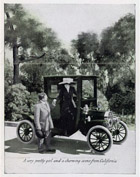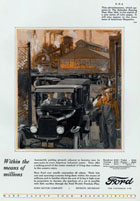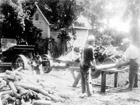 |
Even in 1911, Ford was promising that the right car would attract pretty girls. ID.G32128 |
| |
 |
This 1925 ad targets industrial workers who never thought they could afford a car. ID.G32137 |
| |
 |
| Farmers used their Fords for many things, including powering sawmills. ID.P.O.6499 |
|
When introduced in 1908, Ford’s Model T was thoroughly modern and, at $850, cheap for its day.
- It had a four cylinder engine with a block cast in one piece. That is common practice today, but was unusual in 1908. A typical four cylinder engine of the time had cylinders cast in pairs bolted to a separate crankcase. A one piece block was stronger, lighter, and cheaper to assemble.
- The engine had a removable cylinder head. Again this is normal today but not common in 1908. It made tasks like grinding the valves, which had to be done frequently at that time, far easier.
- The car utilized vanadium alloy steel, which was both light and strong.
- It had a planetary transmission that was easier to use than the non-synchromesh sliding gear transmissions typical of the times.
- The frame and suspension were highly flexible. That sounds all wrong today, but the United States had perhaps the worst roads in the industrialized world. A flexible chassis was more likely to survive on those roads than a rigid one.
- The car also had very high ground clearance, again to help it deal with America’s awful roads.
- The resulting vehicle could reach 40 mph (if you could find a smooth road to drive on) and get 20 miles per gallon.
Ford dealers were sure the new car would be a winner. After seeing the initial announcement one dealer wrote Henry Ford, “It is without doubt the greatest creation in automobiles ever placed before a people and it means that this circular alone will flood your factory with orders.” He was right. Even before the factory had produced a single car, dealers had 15,000 orders—nearly twice the previous year’s total sales.
Ford soon found that he could sell as many Model Ts as he could make---but he wanted to be able to make as many cars as he could sell. Demand for the Model T quickly outstripped the capacity of the Piquette Avenue plant in Detroit, which had been built in 1904. Ford constructed a vast new plant in Highland Park, just north of the Detroit border, and moved there in 1910. At Highland Park, Ford Motor Company engineers relentlessly pursued the twin goals of increasing production and decreasing cost. By the end of 1913, this drive had led them to create a moving assembly line, a development that was as important as the Model T itself. By October 1922, a new Model T could be had for less than $300 and Ford had 50% of the American market.
The ruggedness, low cost, ease of maintenance, and ability to navigate bad roads that made the Model T a success in the United States meant that it was suited to other countries as well. By the time it reached the end of its production in 1927, Model Ts were being made in 19 other countries—Argentina, Australia, Belgium, Brazil, Canada, Chile, Denmark, England, France, Germany, India, Ireland, Italy, Japan, Malaya, Mexico, South Africa, Spain and Uruguay—and the only continent without a Model T assembly plant was Antarctica. The “Tin Lizzie,” as the Model T was nicknamed, was truly the first world car.
In the end the Model T was the victim of its own success. Buyers pushed for better roads and were even willing to pay a tax on gasoline to finance them. As the roads improved the ruggedness that characterized the Model T gradually ceased to be necessary. As drivers became accustomed to the freedom and mobility offered by the Model T, they began to want what customers always want—more. More power, more comfort, more speed, more colors. Henry Ford so loved his great creation that he stayed with it too long. Sales fell off and market share declined.
By the time the 15 millionth Model T came off the Highland Park assembly line on May 26, 1927, it looked contemporary, but underneath it was not fundamentally different from the original car built in 1908. The Model T was obsolete technology, rapidly being superseded by more powerful, more comfortable, more stylish competitors. But the Model T had nothing to apologize for. It had done enough.
| |
-- Bob Casey, Curator of Transportation |
|

